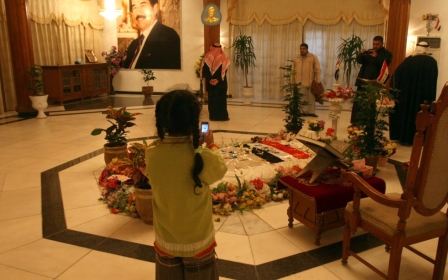Iraq: Re-opening Pandora’s box of horrors

“We told you Americans that Iraq is a tribal country. Why did you not listen?” - a delegation from Qatar told General Wesley Clark as the insurgency reached its zenith in 2005.
Ten years later, and as the 2016 presidential race promises to go into full gear, Americans are lusting for another military excursion into Iraq. The latest Quinnipiac University poll shows that a large majority of the US population now backs the use of ground troops against ISIS.
Nearly two-thirds of registered American voters support US boots on the ground in Iraq, while 69 percent believe America will defeat ISIS in Iraq.
What does this mean?
It means that after two invasions of Iraq, including a 7-year occupation, the loss of 5,000 American lives and $3 trillion, a majority of Americans have learned absolutely nothing about the glue that keeps Iraq together when law and order give way to social chaos - it’s interlocking tribal system - and thus are setting themselves up to repeat the same mistakes of the past.
“Terrain is fate in ground combat operations,” says Jim Hickey, a US army colonel. “Iraq is a tribal society, and families and tribes are tied to specific pieces of ground.” Tribal support is particularly crucial in the non-urban parts of Iraq - it’s in the sparsely populated northwestern corridor where ISIS holds most of its terrain.
It is estimated that up to 75 percent of Iraq’s population belongs to one of the 150 something tribes - with Sunni tribes in central and western Iraq, Shitte tribes in the south, and Kurdish tribes in the north. And this is still an overly simplified summary of Iraq’s tribes, given there are Shiites who belong to Sunni tribes, and vise-versa.
Saddam’s deep insight and patronage of Iraq’s tribal society is what kept him in power for so long. “Prewar Iraqi state television channels prominently featured tribal traditions and folklore and Saddam personally mingled with both Sunni and Shia sheikhs, dispensing various incentives - such as smuggling and gray-market rights - for their continued fealty. It was this established patronage system that AQI self-defeatingly tried to disrupt in the mid-2000s, precipitating Sahwa (awakening) in Iraq.”
America’s failure to understand tribal dynamics is why US military planners were blind-sided by the insurgency. America’s continued ignorance of Iraq‘s tribal society is why a majority of Americans again demand the deployment of US combat troops. A demand Americans would be reticent to make were they able to comprehend these tribal complexities.
US combat troops were unable to defeat ISIS, or its earlier incarnation al-Qaeda in Iraq (AQI), and US combat troops never will permanently defeat ISIS, or any incarnation of ISIS because of these tribal and sectarian complexities.
I’ll explain why, but first, here’s some perspective: by the time the US exited Iraq in 2010, ISIS, which, in simple terms, used to be al-Qaeda in Iraq (AQI), had lost 84 percent of its fighting force. Their fighters had either been killed or fled the battlefield. Imagine any organisation, commercial or public, losing nearly 9 out of 10 of its workforce, but only to return bigger and stronger a mere 4 years later.
Those unfamiliar with Iraqi tribal society will look at the above data and draw a fatal conclusion: ISIS returned “bigger and stronger” because US combat troops withdrew from Iraq, therefore by extrapolation the strategy for defeating ISIS is insert US combat troops. Wrong!
Why is the above conclusion wrong? We can answer that question with a history lesson.
In the first few months that followed the topping of Saddam’s statue in 2003, no one fought against the Americans. There was no AQI and there was no insurgency. After three decades of Saddam’s rule, a plurality of Iraqis had had enough. But whatever grievances Iraqis had with the Saddamists, his socialised regime kept the electricity on, people in government jobs, and the country generally functional. The US toppled Saddam’s regime with no governing blueprint to put in its place. The first blunder was to put 500,000 Baathists on the unemployment line. The second was to forgo law and order. The third was a failure to understand Iraq’s sectarianism guarantees majoritarian rule in a democratic process. “When the Americans formed the Governing Council [in July 2003] with thirteen Shiite and only a few Sunnis, people began to say, ‘The Americans mean to give the country to the Shia,’ and then they began to fight, and the tribes began to let al-Qaeda in,” writes Joel Rayburn in Iraq After America: Strongmen, Sectarians, and Resistance.
Why did the Sunni tribes let AQI in? In their minds, the toppling of Saddam, and the de-Baathification that followed, confirmed, at least in Sunni minds, that the invasion of Iraq was a US - Iranian plot to implement a Shiite central government in Baghdad.
The arrival of foreign jihadis, led by AQI’s al-Zarqawi, set off not only an insurgency against the Americans, but also a sectarian civil war between the Shiite majority and the Sunni minority. When Shiite militias, with the backing of the Iranian regime, began exacting revenge and committing atrocities against Sunni majority towns and villages in late 2003, AQI’s proposal to Iraq’s Sunni tribes was simple to understand: “Our violence or theirs?” Military historian Ahmed Hashim notes that most of the Sunni tribes joined AQI (ISIS) on the grounds that “they were interested in liberating Iraq and not in creating an Islamic state”.
When AQI (ISIS) began setting up mini-theocracies in Sunni towns and villages, Sunni tribal elders began to reject AQI’s 7th century barbarity. The US military seized on this growing dissatisfaction, and was, over the course of many months, able to inspire a Sunni Awakening. “The tribes chafed at the implementation of a seventy century civil code in areas ruled by fundamentalists, many of whom were foreign-born and behaved as badly as the colonial usurpers they were meant to expel. Tribal businesses were disrupted or taken over by those seeking their own monopoly on smuggling, and [ISIS] protected its confiscated interest with a mafia’s thuggish zeal. It justified killing on the basis of market competition,” write Michael Weiss and Hassan Hassan in ISIS: Inside the Army of Terror.
The Sunni tribes were ready to cut a deal with the Americans and the Sunni Awakening was born, which brought together seventeen Sunni Anbari tribes behind the firepower support of the Coalition forces for the purpose of ejecting AQI (ISIS) from their lands. “For centuries these clans had survived by cutting pragmatic deals with perceived dominant powers in their midst. They had done it with Saddam, and they had done it with al-Zarqawi, and they were ready to do it with the Americans. And while they regarded the United States warily, they saw in its army a possible ally against a greater common enemy,” note Weiss and Hassan.
By 2008, the Sunni Awakening had evolved into a 90,000 strong militia called the Sons of Iraq, which left AQI outmanned, outgunned, and ever more unwelcomed by the Sunni population. AQI (ISIS) was defeated.
Two years later, the Sunni Awakening would’ve counted for naught, however, as the US military exit in 2010 would again leave the Iranian backed Shiite majority government in Baghdad free to harass, persecute, and attack the very Sunni militias that had cooperated with the Iraqi central government to rid the country of AQI. This put Iraq back on the same trajectory it was in late 2003, and today Iraq is where it was in 2006 - with ISIS (AQI) controlling Sunni tribal lands in Anbar province. “People don’t believe in the term Awakening anymore because when the Iraqi government finished using the tribes, it turned against the Sons of Iraq,” Dr. Jaber al-Jaberi, a senior political advisor to the former Deputy Prime Minister Rafi al-Isasawi, told Weiss and Hassan. “It didn’t give them rights, it didn’t pay their salaries, and it put a lot of them in jail. I don’t think the tribes will do another Awakening.”
Moreover, ISIS, having learned from their predecessor’s mistakes, has fully co-opted a majority, nearly all, Sunni tribes in Anbar. How? ISIS shares revenues from its oil smuggling operations with the tribes living within their controlled territory. Even more Machiavellian, ISIS has successfully implemented a divide-and-rule strategy by bribing key figures within each respective tribe. Weiss and Hassan explain how “one tribal figure from Albu Kamal explained how ISIS deftly uses this generational-political divide in one prominent family months before it had even established any presence in the area.” The tribal figure told them: “They [ISIS] are giving a portion of an oil well in the area. They know that if they are to be eradicated in our area, who would be able to rally up people around him? Most of the other tribes in our area have no leadership; we have leadership; we have leadership and influence. They give him money, they protect him and consult with him on everything. The other option is, they would assassinate him.”
These are the dynamics a US infantry group would have to deal with. Essentially, any strategy for defeating ISIS that is dependent on US combat troops is guaranteed to eventually bring us back full circle to where we are today. Even if the US could inspire and arm another Sunni Awakening, which again wipes out 90 percent of ISIS’s fighting force, like it had in 2010, the Sunni fear of Shiite militias will have gone nowhere, and the sum of all Sunni fears - an Iranian-backed regime in Baghdad - would also remain intact. It’s this fear that provides fertiliser for ISIS or another anti-Shiite identity to take root.
There is no easy answer. Iran and its “dirty brigades” have now taken the lead in defeating ISIS. Some of these militias, including the US-trained Iraqi military units, are under investigation for perpetrating the same atrocities as ISIS.
"What we are watching carefully is whether the [Shiite] militias - they call themselves the popular mobilisation forces - whether when they recapture lost territory, whether they engage in acts of retribution and ethnic cleansing,” Chairman of the Joint Chiefs Gen Martin Dempsey told the US Congress.
Officials from Human Rights Watch have already confirmed that anti-Sunni atrocities are already taking place. "Usually when forces commit such crimes they try to hide them. What we are seeing here is a brazen, proud display of these terrible crimes," said Sarah Leah Whitson, Middle East executive director at Human Rights Watch.
While there is no easy solution to the Pandora’s box of horrors the 2003 US invasion of Iraq opened, the US is not the fix, especially when Iraq is being used as a proxy war between our Sunni Arab allies and the Iranian regime. But the lesson from the Sunni Awakening is obvious: if Sunni tribes feel secure and in control of their own destiny, they’ll reject ISIS as fast as they had rejected AQI more than five years ago. How we get there, nobody seems to know.
- CJ Werleman is the author of Crucifying America, God Hates You. Hate Him Back, Koran Curious, and is the host of Foreign Object. Follow him on twitter: @cjwerleman
The views expressed in this article belong to the author and do not necessarily reflect the editorial policy of Middle East Eye.
Photo: Mourners are seen during the funeral ceremony for 16 people found in the village of al-Bashir in a mass grave, at Martyr's cemetery in Tuzhurmatu district of Kirkuk, Iraq on 15 March (AA)
New MEE newsletter: Jerusalem Dispatch
Sign up to get the latest insights and analysis on Israel-Palestine, alongside Turkey Unpacked and other MEE newsletters
Middle East Eye delivers independent and unrivalled coverage and analysis of the Middle East, North Africa and beyond. To learn more about republishing this content and the associated fees, please fill out this form. More about MEE can be found here.





